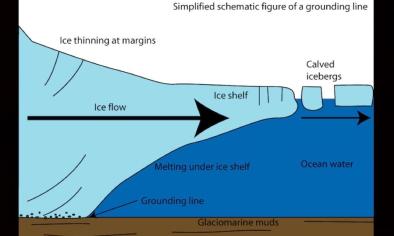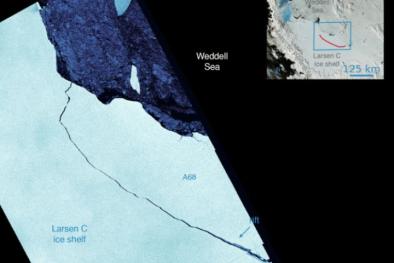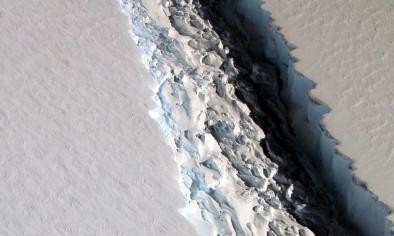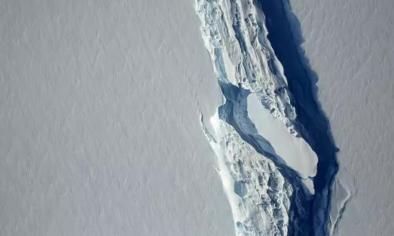American Geophysical Union AMA: Hi Reddit, I’m Chris Borstad, and I’m here to talk about the peculiar nature of snow and ice related to avalanches and glaciers. Ask Me Anything!

American Geophysical Union AMA: Hi Reddit, I’m Chris Borstad, and I’m here to talk about the peculiar nature of snow and ice related to avalanches and glaciers. Ask Me Anything!
...For ice (or any other material) to fracture naturally, you need a something that causes a locally high amount of force. For glaciers and ice shelves, cracks are commonly formed in areas where the ice speeds up, such as when a glacier spills over the crest of a steep slope. Many cracks in Larsen C originate in places where the ice speeds up after flowing past the end of a peninsula (the ice scrapes along the side of the peninsula, which slows it down somewhat until it clears the end of the peninsula). Many of the details of crack formation are still unknown, however, and this is a key focus of much of my research
..
Larsen C is thickest where it first comes afloat, at around 600 m (2000 ft). It gradually gets thinner as it flows out into the ocean, tapering to around 250 m (~800 ft) thick at its furthest extent from land.
...
As for the consequences, most of the ice removed by the iceberg is “passive” and won’t make a big difference to the ice shelf in the short term. Myself and colleagues have done some computer modeling of the ice shelf that indicates the remaining ice should speed up a little bit after the iceberg is released. The next big question is whether we will see similar large cracks open up in the ice, or perhaps a transition to more frequent, smaller icebergs gradually eating away at the shelf (which is what happened to the neighboring Larsen B ice shelf prior to its disintegration in 2002).
...
We don’t know yet whether the current crack in Larsen C was related to climate change. Icebergs are regularly released from ice shelves, even in a stable climate. Floating ice can only spread out and thin so much before it becomes susceptible to cracking. It is possible, however, that warmer ocean currents may have been melting the bottom of the ice shelf, which may have made it easier for this crack to begin growing in the first place. This would be a plausible connection to climate change, but we have to do more research to know for sure. It is very hard to figure out what is happening in the ocean beneath hundreds of meters of ice!
...
For this one iceberg, the consequences are likely to be relatively minor. A model I have developed for Larsen C indicates that the remaining ice will likely speed up a little bit after the iceberg detaches. The biggest potential long term implication is if Larsen C continues to weaken and eventually collapses entirely. Ice shelves are kind of like glacier traffic jams: they form when neighboring glaciers flow into the ocean, merge together and attempt to spread out in the water. The ice on land is at the back of this traffic jam, and has to slow down before it can reach the ocean. When an ice shelf disintegrates, this traffic jam clears and the ice on land starts to flow much faster into the ocean, and this results in an increase in sea level. So ice shelves indirectly influence sea level because they are slowing down the rate at which ice on the continent reaches the ocean.
...
The biggest potential runaway effect following the release of the iceberg would be further iceberg calving until eventually the ice shelf disintegrates, as its neighbor Larsen B did in 2002 (http://earthobservatory.nasa.gov/Features/WorldOfChange/larsenb.php). For Larsen B, this was like “popping the cork” which allowed the glaciers feeding the ice shelf to begin flowing faster and faster into the ocean. They are continuing to flow faster than they used to, which has increased the sea level contribution from these nearby glaciers. The concern is that Larsen C may have the same fate in the not-to-distant future. We do have models that attempt to predict how/when this may happen, and some results suggest that Larsen C may be quite vulnerable to any further iceberg calving after this current large iceberg detaches.
...
For the most part, ice shelves spread out simply under the action of gravity as they float in the ocean (like pancake batter spreading out in a skillet)
...
Larsen C, as with most ice shelves, does provide buttressing for the tributary glaciers that flow into it. The iceberg that is about to be released comes from the front of the ice shelf that does not provide much buttressing, however. Thus we say that most of the ice removed is already "passive". I did some modeling work in a 2013 paper to quantify how much buttressing Larsen C provides.
You can look at Figure 5 in this paper:
http://www.the-cryosphere.net/7/1931/2013/tc-7-1931-2013.pdf
There isn't much color in the front part of the ice shelf where the iceberg will be detached. Other colleagues of mine have made similar model predictions. However, if more is is lost, then you start to eat away at the "buttressing" ice!
Related Content






